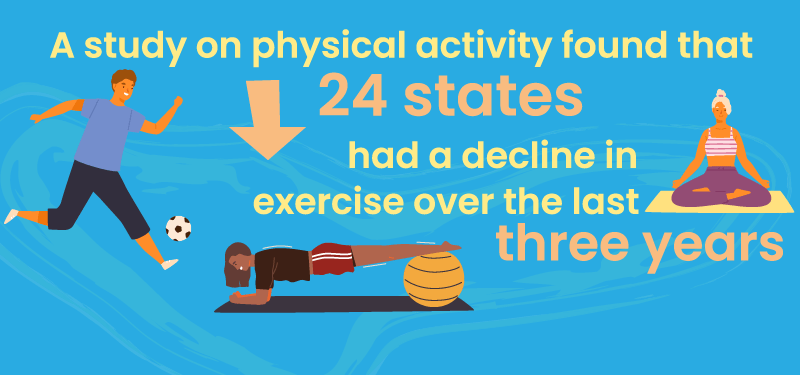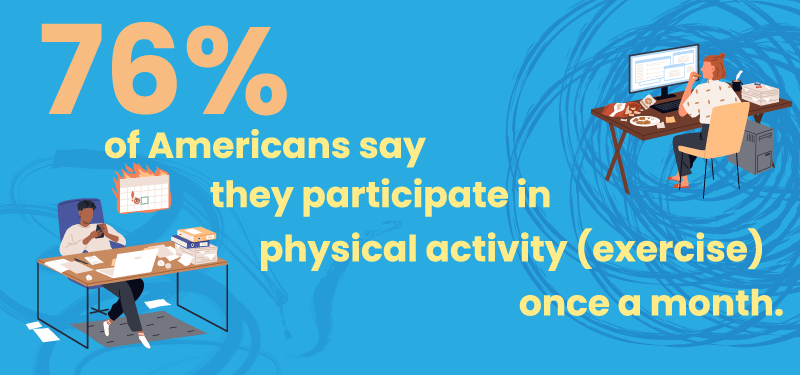Americans are becoming less active, and it’s impacting their health. Our team of analysts found that over the last four years, exercise rates have fallen by 1%, while obesity rates have risen by 10%.
Key findings:
- Colorado, Utah and Washington are the most physically active states
- Alabama, Mississippi and Arkansas are the least physically active states
- Obesity rates have increased by as much as 30% in some states
- Exercise rates increased during the height of the coronavirus pandemic, while obesity rates declined
Most physically active states
Nationwide, more than one-third of Americans (1 in 3) are obese, and 76% say they participate in a physical activity (exercise) once a month. West Virginia, Kentucky and Alabama have the highest obesity rates at around 40%, while Hawaii, Colorado and Massachusetts have the lowest rates of obesity at around 25%.

Colorado, Utah and Vermont are the most physically active states. More than 80% of people in those three states exercise. Alabama, Mississippi and Arkansas are the least physically active states, with less than 70% of people in those states exercising regularly.
When looking at obesity and exercise rates nationwide, a pattern quickly emerges: States that exercise more have lower rates of obesity.
| State | % of people who exercise | % of people who are obese |
|---|---|---|
| Colorado | 83% | 25% |
| Utah | 83% | 31% |
| Washington | 82% | 29% |
| Vermont | 82% | 29% |
| Oregon | 80% | 30% |
| Hawaii | 80% | 25% |
| New Hampshire | 80% | 31% |
| California | 80% | 28% |
| Minnesota | 80% | 32% |
| Alaska | 80% | 34% |
| Wisconsin | 80% | 34% |
| Idaho | 80% | 32% |
| Virginia | 79% | 34% |
| Massachusetts | 79% | 27% |
| Montana | 79% | 32% |
| Maryland | 78% | 34% |
| North Carolina | 78% | 36% |
| Arizona | 77% | 31% |
| Connecticut | 77% | 30% |
| Wyoming | 77% | 32% |
| New Mexico | 77% | 35% |
| Michigan | 77% | 34% |
| South Dakota | 77% | 38% |
| Kansas | 76% | 36% |
| Georgia | 76% | 34% |
| New Jersey | 76% | 28% |
| Rhode Island | 76% | 30% |
| Nevada | 76% | 31% |
| Pennsylvania | 76% | 33% |
| Nebraska | 76% | 36% |
| Iowa | 75% | 36% |
| South Carolina | 75% | 36% |
| Texas | 75% | 36% |
| Missouri | 75% | 37% |
| North Dakota | 75% | 35% |
| New York | 74% | 29% |
| Indiana | 74% | 36% |
| Ohio | 74% | 38% |
| Maine | 74% | 32% |
| Delaware | 73% | 34% |
| Illinois | 73% | 34% |
| Oklahoma | 72% | 39% |
| Tennessee | 71% | 35% |
| Louisiana | 71% | 39% |
| Kentucky | 70% | 40% |
| West Virginia | 70% | 41% |
| Arkansas | 69% | 39% |
| Mississippi | 69% | 39% |
| Alabama | 69% | 40% |
| United States | 76% | 34% |
States where obesity rates are rising
Physical activity and obesity rates have changed significantly over the last four years. Our team of analysts found that the number of people considered obese has risen by as much as 30% in some states since 2018. At the same time, exercise rates have both declined and increased by as much as 7% depending on the state.
The number of people who exercise regularly increased the most in New Jersey and decreased the most in Maine. Obesity rates, meanwhile, increased by 30% in South Dakota and decreased or stayed the same in only three states.
| State | % change in exercise rate since 2018 | % change in obesity rate since 2018 |
|---|---|---|
| Alabama | -3% | 11% |
| Alaska | -1% | 14% |
| Arizona | -2% | 6% |
| Arkansas | -2% | 3% |
| California | 1% | 8% |
| Colorado | -1% | 11% |
| Connecticut | -2% | 13% |
| Delaware | -2% | 3% |
| Florida | N/A | N/A |
| Georgia | 3% | 6% |
| Hawaii | -1% | -2% |
| Idaho | -1% | 13% |
| Illinois | -4% | 9% |
| Indiana | 1% | 7% |
| Iowa | -3% | 4% |
| Kansas | -2% | 5% |
| Kentucky | 0% | 11% |
| Louisiana | 1% | 5% |
| Maine | -7% | 6% |
| Maryland | 1% | 12% |
| Massachusetts | 1% | 8% |
| Michigan | 0% | 6% |
| Minnesota | 0% | 9% |
| Mississippi | 0% | -1% |
| Missouri | 0% | 7% |
| Montana | 0% | 20% |
| Nebraska | -1% | 6% |
| Nevada | 0% | 7% |
| New Hampshire | 1% | 4% |
| New Jersey | 5% | 12% |
| New Mexico | -2% | 5% |
| New York | -3% | 7% |
| North Carolina | 1% | 11% |
| North Dakota | -5% | 0% |
| Ohio | -2% | 13% |
| Oklahoma | -3% | 13% |
| Oregon | -2% | 3% |
| Pennsylvania | -2% | 9% |
| Rhode Island | 0% | 10% |
| South Carolina | 1% | 6% |
| South Dakota | 0% | 30% |
| Tennessee | 1% | 3% |
| Texas | 0% | 4% |
| Utah | 0% | 10% |
| Vermont | 0% | 7% |
| Virginia | 0% | 14% |
| Washington | -1% | 1% |
| West Virginia | -6% | 3% |
| Wisconsin | 1% | 6% |
| Wyoming | -3% | 11% |
| United States | -1% | 10% |
Obesity and exercise during the pandemic
The coronavirus pandemic had a unique effect on exercise and obesity rates. Despite gym closures, lockdowns and stay-at-home orders, exercise rates went up slightly in 2020. The number of people who exercised went from 74% in 2019 to 78% in 2020, before ultimately dropping back down to 76% in 2021.

The rise in exercise rates during the height of the pandemic also led to a drop in obesity. The number of people considered obese went from 32% in 2019 to 31% in 2020. Obesity rates, however, began to rise during the second full year of the pandemic. Nationwide, 34% of people are now considered obese.
| Year | % of people who exercise | % of people considered obese |
|---|---|---|
| 2018 | 76% | 31% |
| 2019 | 74% | 32% |
| 2020 | 78% | 31% |
| 2021 | 76% | 34% |
Methodology
QuoteWizard analyzed 2018-21 CDC BRFSS data to determine exercise and obesity rates in each state. The CDC considers anyone with a body mass index (BMI) over 30 to be obese.
References:
QuoteWizard.com LLC has made every effort to ensure that the information on this site is correct, but we cannot guarantee that it is free of inaccuracies, errors, or omissions. All content and services provided on or through this site are provided "as is" and "as available" for use. QuoteWizard.com LLC makes no representations or warranties of any kind, express or implied, as to the operation of this site or to the information, content, materials, or products included on this site. You expressly agree that your use of this site is at your sole risk.
